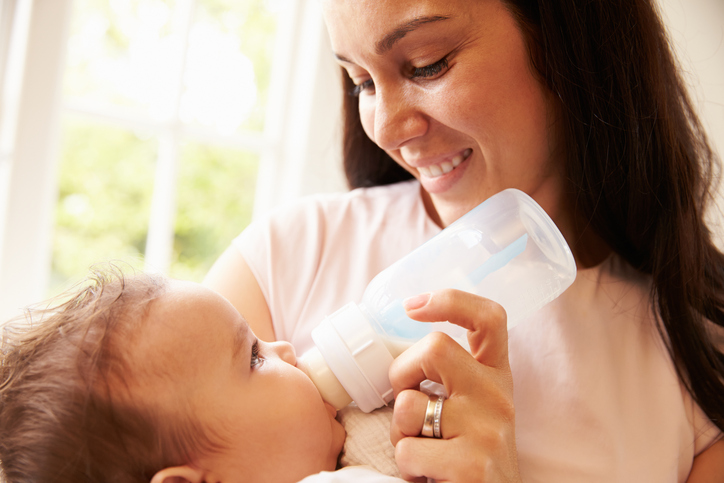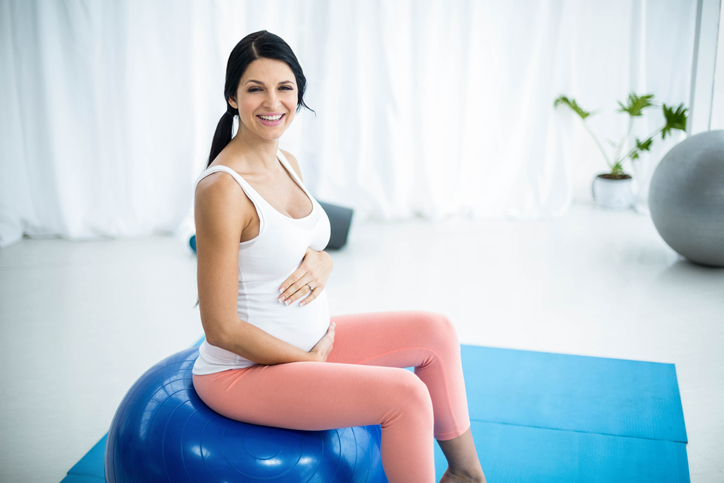We always start by stating the obvious, breast milk is the healthiest thing you can feed your baby. But that doesn’t mean it’s always the “best” thing for your particular situation.
We know that breastfeeding isn’t always possible, at least not exclusively, for a lot of different reasons. And no mom should ever feel shamed or judged for using formula.
For those moms who choose to use or supplement with formula, we’ve got 14 essential formula feeding tips to help make the bottle feeding experience better for you and your baby.
These are the tips that every formula feeding mom needs to know!
Formula Feeding Tips
1. Choose The Right Formula
This is number one for a reason! You want to choose the safest, best formula for your baby. A formula that’s free of the chemicals and the additives that might cause issues for your baby.
Here’s our complete list of tips for choosing the best formula. But in general, we recommend sticking with organic, EU formula brands.
Organic formulas automatically weed out some of the bad ingredients you want to avoid. And the EU has much tighter regulations governing the making of baby formula than the U.S. Plus they have stricter organic and farming requirements.
This means EU brands tend to have less of the ‘bad’ stuff. My Organics is a good source for high-quality EU formula brands.
2. Check The Expiration Date
Before using any formula brand, check the expiration date on the container to be sure the product is still good. Also check to make sure the container isn’t damaged.
If you really want to be extra safe, check the lot number online to be sure there aren’t any recalls.
3. Choose The Right Bottle And Nipple
You want to select something safe, that is going to make feeding your baby easy, without getting too much uncomfortable air in their little tummies. Look for BPA-free plastic or glass bottles to avoid potential carcinogens.
You also want to look for an age-appropriate nipple; newborn ones have smaller holes and they get bigger as your baby grows. This is so they don’t take in too much formula, too soon.
We like PopYum bottles because they’re BPA-free, non-toxic and contain no harmful chemicals. In addition, PopYum has an anti-colic air system that helps reduce the amount of air your child swallows. This, in turn, minimizes uncomfortable pressure and gas in baby’s tummy.
A super cool feature of the PopYum bottle is that it stores formula and water separately in the bottle. When baby gets hungry, you just press the button, shake a few times, and you’re ready to go!
PopYum is designed to be used with one hand, so you can comfort your baby or multitask with your other hand. It makes late night or on-the-go formula feedings a lot easier.
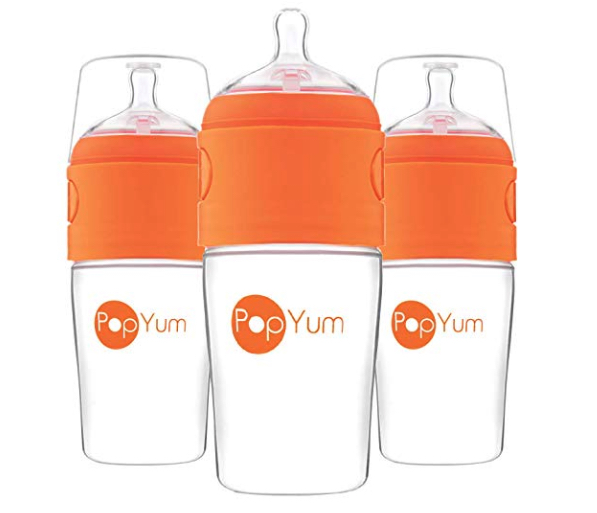
4. Sterilize For Safety
Bottles, nipples, caps and rings should be sterilized for safe formula feeding by boiling for at least five minutes before you use them the first time. After that, thoroughly washing in soapy hot water is okay.
5. Mix and Measure
Be sure to mix and measure formula carefully. For powdered formula, pour the water into a clean bottle and add the measured amount of formula. Level off the measuring scoop with a knife.
For liquid-concentrate formula, measure the water that is added with a measuring cup – the lines on the bottle may not be accurate.
6. Use Good Water
Tap water can be full of chlorine byproducts, weed killer, solvents, lead, phthalates, BPA, etc. You don’t want any of that going into your baby.
Do yourself a favor and use filtered water!
7. Warm Carefully
Room temperature milk is ideal for your baby. But whatever you do, don’t warm the bottle in a microwave! This can create hot spots in the milk that can burn your baby’s mouth.
Bottle warmers are okay, but use caution here as they too can overheat milk. A slower, but safer method is setting the full bottle in a bowl of warm water or running it under a warm faucet.
Always test milk temperature on your most sensitive skin before feeding it to your baby. The back of your wrist is a solid choice.
8. Storage and Shelf-Life
Store formula in the back of the refrigerator where it’s coldest. Never freeze formula, and discard any formula that’s been in the fridge 24 hours or more.
Don’t use formula that’s been sitting at room temperature for more than two hours.
Also, discard any leftover formula if your baby doesn’t finish a bottle. Bacteria from your baby’s mouth may have entered the bottle making it unsafe to drink after that.
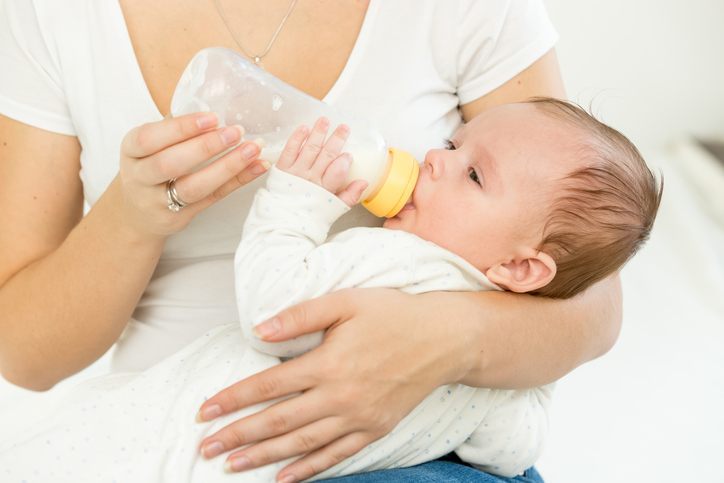
9. Get the Best Angle
When formula feeding, especially at the beginning, you don’t want to overwhelm your baby with milk. Make sure he or she is propped up at an angle (not flat on their back) and that the bottle is at an angle as well.
You want to be in a position where your baby can see your face and you can see theirs so you can watch for signs they need a break.
If the bottom of the bottle is too high, your baby will get overwhelmed with fluid. If it’s too low they’ll get air bubbles.
Keep it at a happy medium and make sure the head of the nipple stays full of milk.
10. Burp Breaks
Your hungry little one may want to suck down a whole bottle in one sitting, but don’t let him! Baby’s little tummy is tiny, and you want to go easy with the bottle feeding at first.
Also, you want to burp your baby mid-feed to get any bubbles up.
Place baby over your shoulder and gently pat their mid back to release air. You may or may not hear a belching sound, sometimes air releases are quiet.
11. Bonding Time
Never leave your baby alone with a bottle propped up against them. For one thing, it’s dangerous. And for another, you’re taking away your baby’s favorite part of feeding, YOU!
Formula feeding is prime bonding time for you and your baby. Look them in the eye, snuggle, and share the moment.
This builds the parent-child connection that is important to your little one’s development.
12. Switch It Up
To mimic breastfeeding, be sure to feed your baby on opposite sides. Switch it up either every other feeding or mid-feed.
Switching sides helps with the brain development that goes along with eye contact.
13. Feeding Accessories
There are some great products on the market to make bottle-feeding easier. For one, a bottle bag is great for feeding on the go. You can try one like this Neoprene 6-Pack Bottle Carrier.
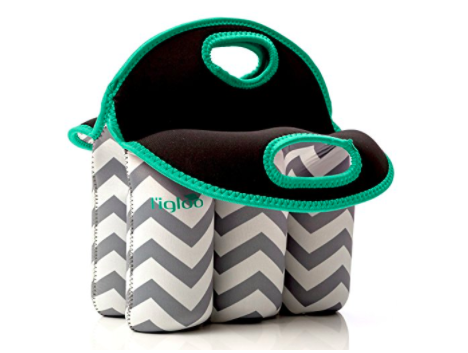
Some other great formula feeding accessories include:
- Stackable Formula Dispenser
- Bottle Holder Comfort Toy
- Grass Bottle Drying Rack
- Branch Bottle Drying Rack
14. Ignore The Haters
If you’re formula feeding, you’re doing it because it’s what is best for you and your baby. Your reasons are nobody else’s business.
But you’ll likely encounter some very judgy folks who think what you’re doing is wrong. Don’t let them mom shame you!
You know what’s best for your family, they don’t.
Formula feeding is the right choice for many parents. In some cases, the greatest benefit from formula is the relief it gives moms that have been struggling.
Formula can be help stop you from stressing, and let your focus on spending quality time with your baby.
SHARE these essential formula feeding tips on Facebook or Pinterest by clicking the buttons below.
